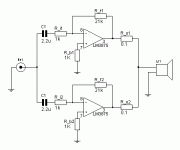I found this schematic at the following site:
http://www.euronet.nl/~mgw/diy/amps/uk_chainclone_1.html
and was wondering how to bridge it. The site just said to build 2 and bridge them. Anotherwords does that mean to just connect the gnd on the speaker to the second amps output, and remove the input connector on the second amp?
Also, the schematic uses a LM3875. What would be better in this application? A 3875 or a 3886? Also, how much voltage and amperage be needed for this circuit. I have a transformer that puts out 48VCT, and somewhere below 4A. I am not sure of the measurement, but I will check. It came from the surplus store unmarked, and since it doesn't blow my rectifier, it mush be under 4A.
Thanks, Mike
http://www.euronet.nl/~mgw/diy/amps/uk_chainclone_1.html
and was wondering how to bridge it. The site just said to build 2 and bridge them. Anotherwords does that mean to just connect the gnd on the speaker to the second amps output, and remove the input connector on the second amp?
Also, the schematic uses a LM3875. What would be better in this application? A 3875 or a 3886? Also, how much voltage and amperage be needed for this circuit. I have a transformer that puts out 48VCT, and somewhere below 4A. I am not sure of the measurement, but I will check. It came from the surplus store unmarked, and since it doesn't blow my rectifier, it mush be under 4A.
Thanks, Mike
Attachments
AN1192
Have a look at the application note AN1192 at National Semi
http://www.national.com/an/AN/AN-1192.pdf
Its got all the basics & theory you will need to get started
Cheers
Paul
Have a look at the application note AN1192 at National Semi
http://www.national.com/an/AN/AN-1192.pdf
Its got all the basics & theory you will need to get started
Cheers
Paul
You need to go back to that site and note that there are two different configurations shown: one is inverting (the one shown in your attachment) and the other is non-inverting. What you need to do is build one of each of these, then connect the speaker between the output of the inverting one and the output of the non-inverting one. What you will have done is bridged together two amps, each of which is itself a parallel amp. The effective load is the same as for a single amp device running normally, but since you are using four of them, you get about 4 times the total output power for a given load (speaker).
You can use either the 3875 or the 3886, but note that the 3875 is better suited to 8 ohm loads, and the 3886 is better suited to 4 ohm loads. So the choice of amp device will be based on what speaker you plan to drive with this amp. The desired + and - rail voltages, and the current required, will also depend on the speaker (it will be a lower voltage but higher current for a 4 ohm than for a 8 ohm speaker).
Take a look at this page at National to see the output power of their various amp chips for 4 and 8 ohm loads. Also take a look at this application note at National, which describes how to make bridged, parallel, and bridged-parallel amplifiers.
You can use either the 3875 or the 3886, but note that the 3875 is better suited to 8 ohm loads, and the 3886 is better suited to 4 ohm loads. So the choice of amp device will be based on what speaker you plan to drive with this amp. The desired + and - rail voltages, and the current required, will also depend on the speaker (it will be a lower voltage but higher current for a 4 ohm than for a 8 ohm speaker).
Take a look at this page at National to see the output power of their various amp chips for 4 and 8 ohm loads. Also take a look at this application note at National, which describes how to make bridged, parallel, and bridged-parallel amplifiers.
- Status
- Not open for further replies.
